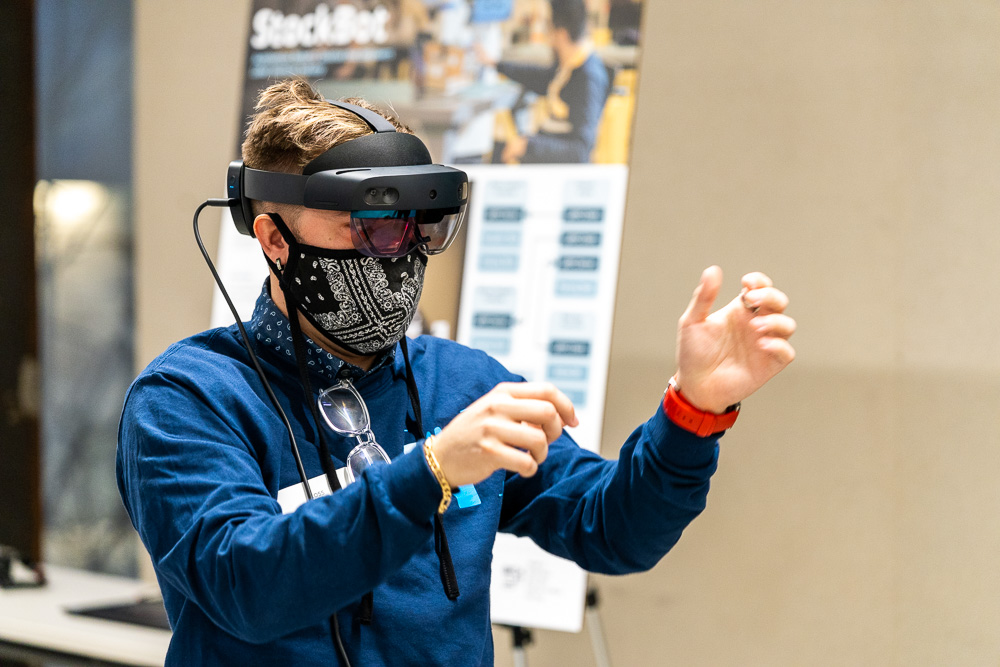“Our shared value was to learn the new technology (AR). We wanted high-quality outcomes, and we got them.”
For every MSTI student, the last six months of the program truly is the time to shine. They form teams and apply the knowledge and experience accumulated from previous quarters to create their industry-sponsored Launch Projects. These projects use the latest in emerging technologies like Cloud Computing, Augmented Reality, Virtual Reality, Machine Learning, and Applied Robotics to address real-world problems. AR-Tho is one of seven launch projects being developed by the class of ’21. We sat down and talked to Ross Todrzak, Shannon Truong, Wesley Muthemba, and Yue Yu about how they are designing, building, and launching their project, which uses Augmented Reality to improve medical training.
Tell me about the problem that your team worked to solve.
The initial inspiration came to us a year ago. A doctor friend of Yue from China revealed that orthopedic surgeons could benefit from a better training strategy, and our market research indicated that most hospitals’ surgical training simulations are expensive and time-consuming. Residents get even less practice opportunity and feedback as surgeons have become increasingly busy since the pandemic. Serious consequences occur when surgeons don’t receive enough training. That’s when we decided that we wanted to create something that could fix the problem.
And how did you work to fix it?
We built AR-Tho. It is an augmented reality training platform that overlays virtual anatomy onto physical body models. The features we designed for AR-Tho can help provide orthopedic surgeons and residents with more repeatable, immersive, and low patient risk practice opportunities.
What was it like working on this team?
None of us had previous experience with Augmented Reality. That was the biggest challenge, but it turned out that we all benefited from it! We did all the learning together from scratch, and we rotated the roles so everyone was able to practice their skill in every aspect. We meet often and have a rule about it: whoever comes late will bring everyone boba (bubble tea).
Wesley: I think we all owe each other boba. One day everyone’s going to get four bobas. We have to do it before we graduate!
Shannon: We also go on a team-building event after each milestone. But sometimes, we get too tired and just go home to sleep. I think other teams should adopt our rules!
What assistance from MSTI faculty or your sponsor have you received in the development process?
We worked closely with our sponsors John Raiti and Linda Wagner in every stage of the project. We were also instructed by professionals from GIX founding partners Microsoft and T-Mobile. The resources in the Steve Ballmer Building include the VR room, the prototyping lab, and the HoloLens, which saved us a lot of money from our $10,000 project budget. Thanks to the program’s connections with UW Medicine, we got to interview multiple orthopedic surgeons and residents who are potential users of AR-Tho. The feedback they gave based on their first-hand experience was extremely beneficial.
What did you learn about working with Augmented Reality?
Ross: One crucial takeaway is to always make sure you are using AR for what it’s best at. We have constantly run into things that would look better in virtual reality (VR). The related technology has nice effects on fictional realities, while AR is new and harder to learn. Translating 2D to 3D spatial awareness is what only AR can do, and our goal is to visualize different layers of the skin, bones, and veins so the trainers can translate book knowledge to real-life practice.
What would you like to say to the future students of the MSTI program?
Team: It’s exciting to see the new students in-person after the pandemic and take advantage of the onsite resource. The program gives you the chance to get your feet wet in many fields. So take the opportunity, find your passion, and dive into it. Whether you are coming in with some working experience or come from a non-technical background, we’re confident that you will get the new experiences you want in the program.
Just like Ross, Shannon, Wesley, and Yue, many more students in the University of Washington’s MS in Technology Innovation program are learning, exploring, and creating to fulfill their own goals. Every year, our cohorts finish their journey in the Steve Ballmer Building and move on to pursue careers as project managers, software developers, data scientists, and more. Meanwhile, our alumni around the world are contributing to various fields ranging from cloud computing, robotics, augmented reality to biotechnology.
Are you ready to empower your career with us? Learn more about the MSTI or sign up to attend one of our upcoming virtual info sessions.




